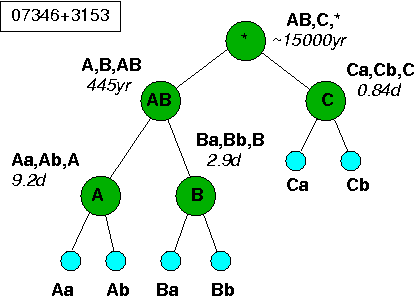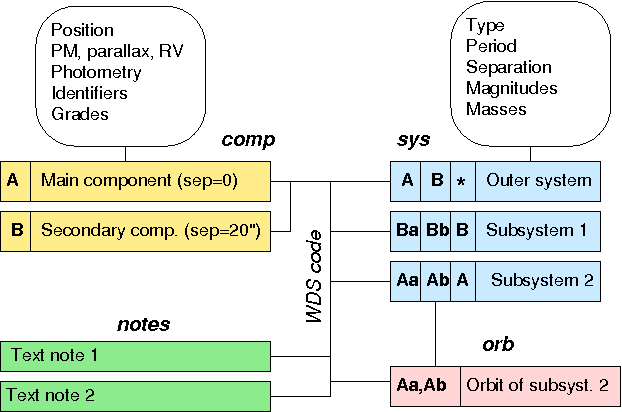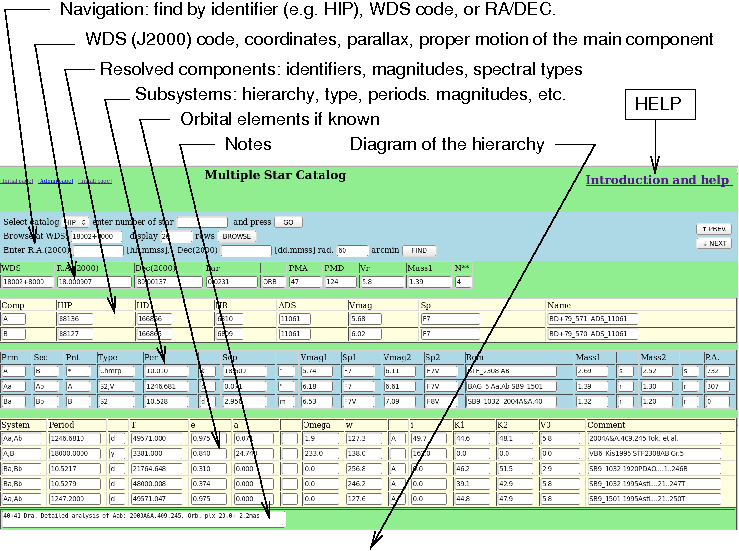Web interface See also:
Vizier: J/ApJS/235/6 (click on the WDS code to get information on each system).
Multiple Star Catalog (MSC)
 This is a catalog of hierarchical multiple stellar systems with three or more components. These systems are organized as "nested" binaries, their structure is reflected in the binary-tree ("mobile") diagrams like the one on the right, representing the Castor system with 6 components. The MSC contains about 2000 hierarchical systems with 3 to 7 components each.
This is a catalog of hierarchical multiple stellar systems with three or more components. These systems are organized as "nested" binaries, their structure is reflected in the binary-tree ("mobile") diagrams like the one on the right, representing the Castor system with 6 components. The MSC contains about 2000 hierarchical systems with 3 to 7 components each.
Structure of the Catalog
 The MSC consists of four tables linked by the common WDS code, unique for each system (see the picture on the left).
The MSC consists of four tables linked by the common WDS code, unique for each system (see the picture on the left).
The main table comp gives basic data (position, identifiers, magnitudes, etc.) on the main component of each system. If there are several components with such information, there are also entries for the secondary components, distinguished from the primary by their non-zero separation (usually >10arcsec).
The table sys lists data on the individual sub-systems: the components' identifiers ("parent" indicates the location of each subsystem in the hierachy, starting with the upper-level root system with parent "*"). Type of the system indicates the observing techniques used to detect and study it (e.g. "v" for close visual binaries). Then follow the period, separation, magnitudes and estimated masses of the primary and secondary components.
The orb table gives the orbital elements when available, in standard notation. Comments on each multiple system can be found in the table
notes.
The MSC is described in the original paper
(Tokovinin, A. MSC - a catalogue of physical multiple stars. Astron. Astrophys. Suppl. Ser., 1997, 124, 75-84).
The latest updated version of the MSC is described here
(Tokovinin, A. The updated Multiple Star Catalog. 2018, ApJS, 235, 6; see also the journal link ).
Access to the MSC
-
Latest MSC version (January 1, 2024): newmsc-20240101.tar.gz (1.63 MB).
Readme describes the tables.
- Previous version (February 7, 2023): newmsc-20230207.tar.gz
- Previous version (September 8, 2021): newmsc-20210908.tar.gz (885 kB) (also available through Vizier).
- The old (April 2010) MSC version is posted here .
- The web interface displays the information through the
brouser and allows search using identifiers, position, or WDS code.
Its content is explained below. The web interface shows only a subset of the
information on each system. Last update: September 8, 2021.

-
Navigation panel (blue, upper part). You can examine each
system sequentially (PREV/NEXT buttons), search for objects with known
catalogue numbers HR, HD, ADS, HIP ( if not found, the next largest number
will be displayed), browse and select objects from a table (specify
the initial WDS code, even incomplete like '13' or '0812', and the
number of rows to display), or search by the R.A. and Dec.
equatorial coordinates within some radius.
-
Main entry (green) gives the WDS(2000) code, equatorial
coordinates of the primary (2000), parallax (arcseconds), proper
motions in [mas/yr], radial velocity [km/s], mass of the
"heaviest" component (solar masses), and the total number of known
components N**.
-
Cross-identifiers (light yellow) are given as one or several
lines with catalogue numbers, visual magnitudes, spectral types and
optional names. The DM identifiers are no longer used, but can be found in the remarks field.
-
Systems (blue) contain information for each pair:
designations of the primary and secondary components (or
super-components if composed of several stars), the link to "parent"
component that establishes the hierarchy (* for the root or
upper-level, t for trapezia systems), type of
the system, orbital period and its units (days, years, kiloyears and
Myr), separation (m = milliarcseconds), magnitudes and spectral types
of individual components (with ? if deduced from colors), and comment
for this system. The last columns contain estimated component masses
with their codes , and the position angle.
-
Orbital elements (light yellow) are given when
available. The system to which the elements refer is indicated as
"primary,secondary"
-
Notes for some systems.
-
Graph showing the structure of hierarchical systems as
binary tree. The numbers indicate component's designations,
magnitudes, spectral types and masses. Graphs are produced
automatically using links to parents.
The MSC web interface is programmed by Alex Serbul from the company Qsoft in July 2005.
Notes on the tables
General
Missing numerical values are displayed as zeros!
The periods of wide binaries are estimated from separations,
parallaxes and masses, as explained in the paper. Similarly, the
separations of close binaries are estimated from their periods. The
exact meaning of the "period" and "separation" columns depends
uniquely on the type of the system.
System type codes
-
c - wide, possibly C.P.M. system
-
C - C.P.M. system (sep.>1arcsec);
The following small letters give the criteria used:
h - hypothetical parallax (slow relative motion),
r - common radial velocity,
p - common distance (parallax)
m - similar proper motions.
- X - not a binary (spurious or optical).
-
v - close visual or interferometric system (mostly sep.<1arcsec)
-
V - visual system with computed orbit
-
a - astrometric system without known orbit
-
A - astrometric orbit for invisible companion is computed
-
s - possibly spectroscopic system (var. RV or composite spectrum)
-
S1, S2 - spectroscopic system with computed orbit, single- or double-lined
-
o - occultation binary
-
E - eclipsing binary with known period
-
E* - eclipse time variations
-
e - eclipsing binary, period not known
Mass codes
-
r - given in the original publication
-
a - estimated from spectral type or color index
-
s - sum of masses for the sub-system(s)
-
q - estimated from primary mass and mass ratio of SB2
-
m - minimum secondary mass for SB1
-
v - estimated from absolute magnitude
-
: - uncertain
Please, direct bug reports and other comments to A.Tokovinin, andrei.tokovinin-AT-noirlab.edu or andrei.tokovinin-AT-gmail.com
Last modified: Dec 29, 2023
 This is a catalog of hierarchical multiple stellar systems with three or more components. These systems are organized as "nested" binaries, their structure is reflected in the binary-tree ("mobile") diagrams like the one on the right, representing the Castor system with 6 components. The MSC contains about 2000 hierarchical systems with 3 to 7 components each.
This is a catalog of hierarchical multiple stellar systems with three or more components. These systems are organized as "nested" binaries, their structure is reflected in the binary-tree ("mobile") diagrams like the one on the right, representing the Castor system with 6 components. The MSC contains about 2000 hierarchical systems with 3 to 7 components each.
 The MSC consists of four tables linked by the common WDS code, unique for each system (see the picture on the left).
The MSC consists of four tables linked by the common WDS code, unique for each system (see the picture on the left).
